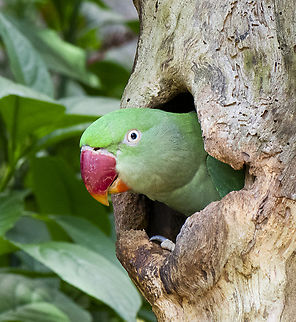
Appearance
The Alexandrine parakeet is one of the largest parakeets, measuring 56 to 62 cm from the top of the head to the tip of the tail and weighing 200 to 300 g. The tail measures 28 to 35 cm. It is predominantly green with a light blue-grey sheen on the cheeks and nape, yellow-green abdomen, red patch on the shoulders and massive red beak with yellow tips. The upper-side of the tail passes from green at the top to blue further down, and is yellow at the tip. The underside of the tail is yellow.Adults are sexually dimorphic. Adult males have a black stripe across their lower cheeks and a pink band on their nape. Adult females lack both a black cheek stripe and a pink nape band. The young are similar in appearance to adult females but have shorter tails.

Naming
The genus name "Psittacula" is a diminutive of the Latin word "psittacus" meaning "parrot", and the specific name "eupatria" is derived from the Ancient Greek words "eu-" meaning "well" and "patriá" meaning "descent".In 2019, a genetic study revived the genus "Palaeornis", formerly viewed as a synonym of the current genus "Psittacula". Some organisations, including the IUCN, have accepted the new taxonomy.
If this were to be taken into account, this could mean that the Alexandine parakeet is the only living member of the now-revived genus.Five subspecies of the Alexandrine parakeet are currently recognized

Behavior
The Alexandrine parakeet has a variety of calls, including a ringing "trrrieuw", loud "kree-aar" or "keeak", deep "klak-klak-klak-klak" and resonant "gr-aak". Its calls are usually deeper, harsher and more resonant than those of the rose-ringed parakeet. Its voice becomes harsher when alarmed, and it shrieks loudly when mobbing predators. Flocks occasionally excitedly vocalize together. It is known to imitate human speech in captivity.
Habitat
The Alexandrine parakeet lives in forests, woodlands, agricultural lands and mangrove forests at elevations of up to 900 m. It eats a variety of wild and cultivated seeds, buds, fruits and nuts. Flocks can cause extensive damage to ripening fruits and grain crops like maize and jowar. It usually lives in small flocks, but forms larger groups in areas where food is abundant or at communal roosts.
Reproduction
Alexandrine parakeets breed from November to April in their native range. They usually nest in tree hollows, but sometimes use tree holes excavated by themselves or cracks in buildings. Females lay 2 to 4 white, blunt oval-shaped eggs, measuring 27 to 34 mm. The average incubation period is 24 days. The chicks fledge at about 7 weeks of age, and are dependent on their parents until 3 to 4 months of age.References:
Some text fragments are auto parsed from Wikipedia.